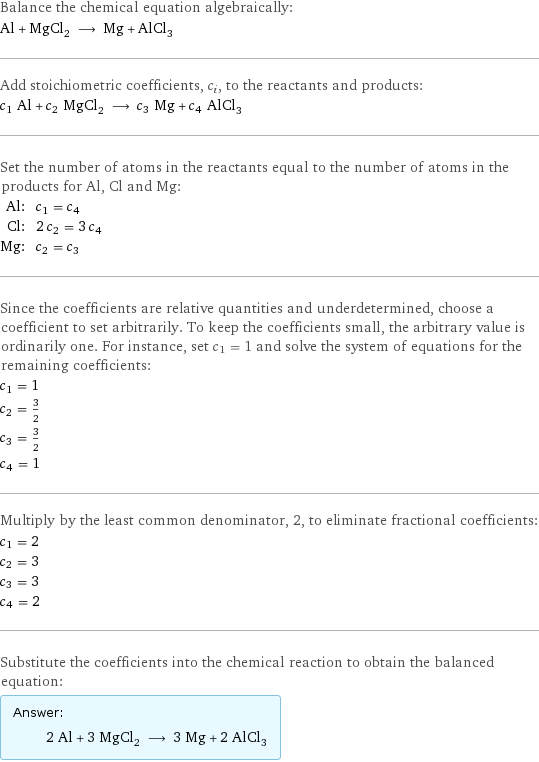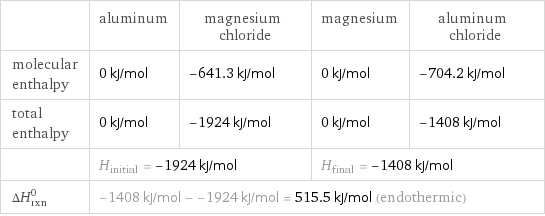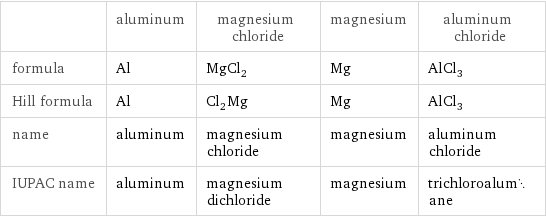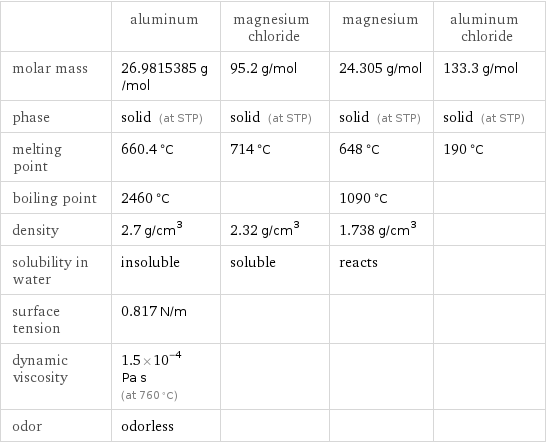Input interpretation

Al aluminum + MgCl_2 magnesium chloride ⟶ Mg magnesium + AlCl_3 aluminum chloride
Balanced equation

Balance the chemical equation algebraically: Al + MgCl_2 ⟶ Mg + AlCl_3 Add stoichiometric coefficients, c_i, to the reactants and products: c_1 Al + c_2 MgCl_2 ⟶ c_3 Mg + c_4 AlCl_3 Set the number of atoms in the reactants equal to the number of atoms in the products for Al, Cl and Mg: Al: | c_1 = c_4 Cl: | 2 c_2 = 3 c_4 Mg: | c_2 = c_3 Since the coefficients are relative quantities and underdetermined, choose a coefficient to set arbitrarily. To keep the coefficients small, the arbitrary value is ordinarily one. For instance, set c_1 = 1 and solve the system of equations for the remaining coefficients: c_1 = 1 c_2 = 3/2 c_3 = 3/2 c_4 = 1 Multiply by the least common denominator, 2, to eliminate fractional coefficients: c_1 = 2 c_2 = 3 c_3 = 3 c_4 = 2 Substitute the coefficients into the chemical reaction to obtain the balanced equation: Answer: | | 2 Al + 3 MgCl_2 ⟶ 3 Mg + 2 AlCl_3
Structures

+ ⟶ +
Names

aluminum + magnesium chloride ⟶ magnesium + aluminum chloride
Reaction thermodynamics
Enthalpy

| aluminum | magnesium chloride | magnesium | aluminum chloride molecular enthalpy | 0 kJ/mol | -641.3 kJ/mol | 0 kJ/mol | -704.2 kJ/mol total enthalpy | 0 kJ/mol | -1924 kJ/mol | 0 kJ/mol | -1408 kJ/mol | H_initial = -1924 kJ/mol | | H_final = -1408 kJ/mol | ΔH_rxn^0 | -1408 kJ/mol - -1924 kJ/mol = 515.5 kJ/mol (endothermic) | | |
Equilibrium constant
![Construct the equilibrium constant, K, expression for: Al + MgCl_2 ⟶ Mg + AlCl_3 Plan: • Balance the chemical equation. • Determine the stoichiometric numbers. • Assemble the activity expression for each chemical species. • Use the activity expressions to build the equilibrium constant expression. Write the balanced chemical equation: 2 Al + 3 MgCl_2 ⟶ 3 Mg + 2 AlCl_3 Assign stoichiometric numbers, ν_i, using the stoichiometric coefficients, c_i, from the balanced chemical equation in the following manner: ν_i = -c_i for reactants and ν_i = c_i for products: chemical species | c_i | ν_i Al | 2 | -2 MgCl_2 | 3 | -3 Mg | 3 | 3 AlCl_3 | 2 | 2 Assemble the activity expressions accounting for the state of matter and ν_i: chemical species | c_i | ν_i | activity expression Al | 2 | -2 | ([Al])^(-2) MgCl_2 | 3 | -3 | ([MgCl2])^(-3) Mg | 3 | 3 | ([Mg])^3 AlCl_3 | 2 | 2 | ([AlCl3])^2 The equilibrium constant symbol in the concentration basis is: K_c Mulitply the activity expressions to arrive at the K_c expression: Answer: | | K_c = ([Al])^(-2) ([MgCl2])^(-3) ([Mg])^3 ([AlCl3])^2 = (([Mg])^3 ([AlCl3])^2)/(([Al])^2 ([MgCl2])^3)](../image_source/06b1ce5c2d6e8d4b47e3677664816dad.png)
Construct the equilibrium constant, K, expression for: Al + MgCl_2 ⟶ Mg + AlCl_3 Plan: • Balance the chemical equation. • Determine the stoichiometric numbers. • Assemble the activity expression for each chemical species. • Use the activity expressions to build the equilibrium constant expression. Write the balanced chemical equation: 2 Al + 3 MgCl_2 ⟶ 3 Mg + 2 AlCl_3 Assign stoichiometric numbers, ν_i, using the stoichiometric coefficients, c_i, from the balanced chemical equation in the following manner: ν_i = -c_i for reactants and ν_i = c_i for products: chemical species | c_i | ν_i Al | 2 | -2 MgCl_2 | 3 | -3 Mg | 3 | 3 AlCl_3 | 2 | 2 Assemble the activity expressions accounting for the state of matter and ν_i: chemical species | c_i | ν_i | activity expression Al | 2 | -2 | ([Al])^(-2) MgCl_2 | 3 | -3 | ([MgCl2])^(-3) Mg | 3 | 3 | ([Mg])^3 AlCl_3 | 2 | 2 | ([AlCl3])^2 The equilibrium constant symbol in the concentration basis is: K_c Mulitply the activity expressions to arrive at the K_c expression: Answer: | | K_c = ([Al])^(-2) ([MgCl2])^(-3) ([Mg])^3 ([AlCl3])^2 = (([Mg])^3 ([AlCl3])^2)/(([Al])^2 ([MgCl2])^3)
Rate of reaction
![Construct the rate of reaction expression for: Al + MgCl_2 ⟶ Mg + AlCl_3 Plan: • Balance the chemical equation. • Determine the stoichiometric numbers. • Assemble the rate term for each chemical species. • Write the rate of reaction expression. Write the balanced chemical equation: 2 Al + 3 MgCl_2 ⟶ 3 Mg + 2 AlCl_3 Assign stoichiometric numbers, ν_i, using the stoichiometric coefficients, c_i, from the balanced chemical equation in the following manner: ν_i = -c_i for reactants and ν_i = c_i for products: chemical species | c_i | ν_i Al | 2 | -2 MgCl_2 | 3 | -3 Mg | 3 | 3 AlCl_3 | 2 | 2 The rate term for each chemical species, B_i, is 1/ν_i(Δ[B_i])/(Δt) where [B_i] is the amount concentration and t is time: chemical species | c_i | ν_i | rate term Al | 2 | -2 | -1/2 (Δ[Al])/(Δt) MgCl_2 | 3 | -3 | -1/3 (Δ[MgCl2])/(Δt) Mg | 3 | 3 | 1/3 (Δ[Mg])/(Δt) AlCl_3 | 2 | 2 | 1/2 (Δ[AlCl3])/(Δt) (for infinitesimal rate of change, replace Δ with d) Set the rate terms equal to each other to arrive at the rate expression: Answer: | | rate = -1/2 (Δ[Al])/(Δt) = -1/3 (Δ[MgCl2])/(Δt) = 1/3 (Δ[Mg])/(Δt) = 1/2 (Δ[AlCl3])/(Δt) (assuming constant volume and no accumulation of intermediates or side products)](../image_source/36fd09ba29d667b8f9c6dded704e58e4.png)
Construct the rate of reaction expression for: Al + MgCl_2 ⟶ Mg + AlCl_3 Plan: • Balance the chemical equation. • Determine the stoichiometric numbers. • Assemble the rate term for each chemical species. • Write the rate of reaction expression. Write the balanced chemical equation: 2 Al + 3 MgCl_2 ⟶ 3 Mg + 2 AlCl_3 Assign stoichiometric numbers, ν_i, using the stoichiometric coefficients, c_i, from the balanced chemical equation in the following manner: ν_i = -c_i for reactants and ν_i = c_i for products: chemical species | c_i | ν_i Al | 2 | -2 MgCl_2 | 3 | -3 Mg | 3 | 3 AlCl_3 | 2 | 2 The rate term for each chemical species, B_i, is 1/ν_i(Δ[B_i])/(Δt) where [B_i] is the amount concentration and t is time: chemical species | c_i | ν_i | rate term Al | 2 | -2 | -1/2 (Δ[Al])/(Δt) MgCl_2 | 3 | -3 | -1/3 (Δ[MgCl2])/(Δt) Mg | 3 | 3 | 1/3 (Δ[Mg])/(Δt) AlCl_3 | 2 | 2 | 1/2 (Δ[AlCl3])/(Δt) (for infinitesimal rate of change, replace Δ with d) Set the rate terms equal to each other to arrive at the rate expression: Answer: | | rate = -1/2 (Δ[Al])/(Δt) = -1/3 (Δ[MgCl2])/(Δt) = 1/3 (Δ[Mg])/(Δt) = 1/2 (Δ[AlCl3])/(Δt) (assuming constant volume and no accumulation of intermediates or side products)
Chemical names and formulas

| aluminum | magnesium chloride | magnesium | aluminum chloride formula | Al | MgCl_2 | Mg | AlCl_3 Hill formula | Al | Cl_2Mg | Mg | AlCl_3 name | aluminum | magnesium chloride | magnesium | aluminum chloride IUPAC name | aluminum | magnesium dichloride | magnesium | trichloroalumane
Substance properties

| aluminum | magnesium chloride | magnesium | aluminum chloride molar mass | 26.9815385 g/mol | 95.2 g/mol | 24.305 g/mol | 133.3 g/mol phase | solid (at STP) | solid (at STP) | solid (at STP) | solid (at STP) melting point | 660.4 °C | 714 °C | 648 °C | 190 °C boiling point | 2460 °C | | 1090 °C | density | 2.7 g/cm^3 | 2.32 g/cm^3 | 1.738 g/cm^3 | solubility in water | insoluble | soluble | reacts | surface tension | 0.817 N/m | | | dynamic viscosity | 1.5×10^-4 Pa s (at 760 °C) | | | odor | odorless | | |
Units
